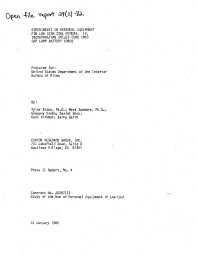Mining Publication: Experiments on Personal Equipment for Low Seam Coal Miners: IV. Incorporating Coiled Cord Into Cap Lamp Battery Cords
Original creation date: January 1980
The objective of this study was to determine optimal personal equipment design for use in low coal based on ergonomic, biomechanic, and safety considerations. This report describes a study designed to evaluate a proposed modification in the cap lamp battery cord intended to reduce the incidence of snagging and catching of the cord. A three-phase evaluation was performed comparing a prototype with the standard, currently available cord. In the first evaluation a "pull test" was performed to measure the reaction time of workers and the maximum force delivered to the helmet. The second evaluation was a body conformity experiment wherein the cords were studied to determine whether they conformed differently to workers bodies. The third evaluation involved workers performing common manual tasks in a low seam coal mine simulator. The results demonstrated significant safety advantages of incorporating coiled cords into the design of the cap cord.
Authors: T Blake, M Sanders, G Krohn, D Wick, K Volkmer, B Beith
Open File Report - January 1980
NIOSHTIC2 Number: 10002401
Pittsburgh, PA: U.S. Department of the Interior, Bureau of Mines, Contract J0387213, 1980 Jan; :1-30
See Also
- Biomechanical Modeling of Spinal Loading Due to Jarring and Jolting for Heavy Equipment Operators
- A Checklist for Evaluating Cab Design of Construction Equipment
- Control Design Principles
- Job Design: An Effective Strategy for Reducing Back Injuries
- Repeatability of a Checklist for Evaluation Cab Design Characteristics of Heavy Mobile Equipment
- Self-Reported Musculoskeletal Symptoms Among Operators of Heavy Construction Equipment
- Systematic Comparison of Different Seats on Shuttle Cars Used in Underground Coal Mines
- Task Analysis
- Transverse-Mounted End-Cab Design for Low-Coal Shuttle Cars
- Underground Workstation Design Principles
- Page last reviewed: 9/21/2012
- Page last updated: 9/21/2012
- Content source: National Institute for Occupational Safety and Health, Mining Program


 ShareCompartir
ShareCompartir
